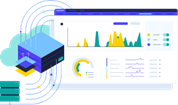-
Call Us:1.800.561.4019
Newsletter
For a Free Quote...
Latest Blog Posts
Blog Categories
Telnet Networks News
Network-based APM: Out with the old, in with new APM approaches
 As IT environments become more complex, so does application performance management. IT professionals need tools that are up for the new challenge.
As IT environments become more complex, so does application performance management. IT professionals need tools that are up for the new challenge.
"Applications are becoming increasingly difficult to troubleshoot, and [it's becoming more difficult to] understand how users are interacting with them," said Jonah Kowall, research vice president of IT operations management at Stamford, Conn.-based Gartner Inc. "Because applications are so diverse, there are a lot of different approaches and solutions right now, and that can create confusion."
A new generation of application performance management (APM) systems are emerging. These networking-based APM technologies could help enterprises better measure and manage end-user experience.
Legacy APM tools collect end-user experience data and performance analytics to track and understand how applications are running across an enterprise's environment. APM can be executed through a series of agent or agentless network probes. In the days when applications were static, monitoring and measuring their performance was a simple process. But today, applications are no longer confined to a single data center, and they are extremely dynamic. Elements of an application could be virtual, cloud-based, mobile or distributed across multiple platforms and environments. Traditional application performance management systems -- much to the frustration of enterprise IT teams -- may no longer be capable of monitoring the performance and availability of distributed and diverse applications.
Network-based APM tools needed for new application environments
Virtualization and cloud makes infrastructure more flexible, which means more change from an IT management perspective. APM tools can get lost in the shuffle of a dynamic application environment, said Jim Frey, vice president of network management research at Boulder, Colo.-based Enterprise Management Associates. "Traditional approaches can't keep up with the administrative aspects of continuously updating and fine-tuning configurations of the APM tools or measure application performance in a mixed environment," he said.
Putting an agent on every server that plays a part in application delivery adds unnecessary overhead. Network administrators can instead use tools that measure application performance by listening to the network -- a method called network-based APM that was pioneered by ExtraHop Networks and now available from some other APM vendors, such as Compuware.
Network-based APM doesn't require instrumentation within each component, or in every place that an application might be in order to measure performance. Using network visibility tools -- from players such as NetScout Systems, Fluke Networks or Riverbed Technology -- enterprises can see application performance and traffic metrics. "This is an excellent, ad hoc way to see if performance is occurring within expected parameters," Frey said. The network viewpoint is also well suited for monitoring virtualized or cloud-based applications, which still travel over the enterprise network.
Interest in network-based APM is growing. While the network viewpoint of APM is important, it will be a new approach for many enterprises who may be expecting a certain level of application visibility that isn't realistic with today's dynamic applications, Frey said. "Enterprises might have to have the same level of detailed information that they used to have -- it's just not practical in the new paradigm," he said.
Organizations are also looking for less complex approaches and alternative deployment options for APM, said Erik Giesa, senior vice president of marketing for ExtraHop Networks. "Because of these modern network infrastructures and degrees of abstraction -- thanks to cloud and virtualization -- traditional approaches to management are falling apart, and that is why we see this degree of dissatisfaction with traditional APM technologies."
In addition to the network viewpoint, collecting wire data is also important to customers looking to improve their APM strategies and add to their overall visibility. Wire data capture can also be obtained without invasive probes or agents that add overhead and unnecessary complexity for internal IT teams, ExtraHop's Giesa said. The ability to decode wire protocols within the user session, in conjunction with the network viewpoint, is the holy grail of APM, he said. "If I can parcel and measure anything that is part of that end-user transaction, now [the enterprise] will have tremendous visibility at their fingertips beyond that network-based, Layer 7 view of APM."
Bridging the gap between expectations, reality of APM tools
Compuware Corp., a Detroit-based APM provider, has acquired several performance management companies -- such as Gomez, dynaTrace and Vantage -- to keep its APM strategy as modern as possible, said John Van Siclen, general manager of Compuware's APM business unit. The company -- like ExtraHop -- also offers network-based APM, as well as software-based monitoring tools. Compuware is encouraging customers to experience the benefits of its more modern, network-based APM tools with proof-of-concept tests, Van Siclen said.
"Many enterprises are still used to the old world and haven't tried any of the new-generation APM tools and systems," he said. "What many don't realize is that to instrument a major, multi-tiered application for a large company is now cheaper and will only take a few minutes compared to the months it would have taken with the old tools, but enterprises don't believe that until they see a proof of concept on an application."
Clinging to the APM tools of the past is the wrong strategy, but the good news is that ripping and replacing legacy APM agents and probes isn't necessary. The process of updating an APM strategy can be done gradually, as applications and environments grow and change, Gartner's Kowall said. "Ripping old monitoring tools has no benefit, but IT will often gradually start to look for products that work better for cloud environments or maybe virtualization or mobile deployments," he said.
IT departments may have been oversold on the capabilities of legacy APM tools in the past and there are a lot of environments these tools can't natively support, Kowall said. "Some vendors in this space try to flood the market with messages that try to differentiate what they do versus everyone else, and those messages are confusing buyers," he said. "But the core desires of APM are pretty clear -- enterprises want user experience monitoring first, and then troubleshooting."
Despite the confusion over the state of APM, the need for new APM tools is only growing. "Users need to know how they can be more active in managing the services they offer, whether it's to their own employees or even their end customers," Compuware's Van Siclen said.
Thanks to TechTarget for the article.
When you subscribe to the blog, we will send you an e-mail when there are new updates on the site so you wouldn't miss them.





Comments